|
|
| << PREV |
|
|
Had I been present at the Creation, I would have
given some useful hints for the better ordering of
the universe.
ALFONSO THE WISE
(Thirteenth century A.D.)[1]
The French Revolution in the eighteenth century had given violent birth to socialist humanism. While it was being acted out in a baptism of blood, a far different kind of revolution was taking place just across the English Channel. The Industrial Revolution in England, a gradual and more carefully orchestrated affair, generally free of violence, provided an intellectual atmosphere that promoted science. In turn, the resultant understanding of the forces of nature offered man power. Quite literally, steam power was the prime mover of the Industrial Revolution. While the nineteenth century capitalist society had its faults, it did nurture every field of the arts. Some of the finest music, literature, architecture, and art was produced during this period.
| It is perhaps difficult to appreciate from our point in time that before
the Industrial Revolution the average man lived in the country and for
the most part lived off the land. Men were very familiar with the flora
and fauna around them and unquestioningly saw the divine hand in perfect
harmony with nature (which we prosaically refer to today as "ecology").
The Industrial Revolution brought country people into the cities and into awful working conditions where they no longer saw the beauty of nature. Even the sunsets were obscured by the interminable serpents of black smoke from "those dark satanic mills", to use words penned by a poet of the day (Blake 1966, 481 ).[2] As the first generation of mill workers passed into the second, some, in viewing their squalid and mechanistic surroundings, lost their belief in divine creation. |
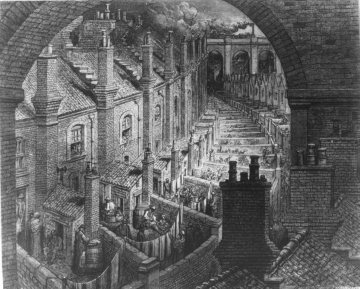
London as seen by Gustave Doré in 1872. Living in these surroundings, many lost their appreciation for the beauty of nature as evidence of their creator. (Engraving by Pannemaker after a drawing by Doré; Metropolitan Toronto Reference Library Board) |
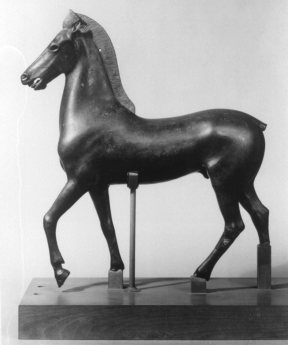
This small bronze horse had been produced in 450 B.C. by a casting technique rediscovered in the fourteenth century A.D. Suspected as a fake, modern technology has reinstated it as genuine. (The Metropolitan Museum of Art, New York; Fletcher Fund, 1923) |
Others experienced an inner yearning to recapture the beauty of nature, and there awoke among the people a tremendous interest in natural history. It was in nineteenth century England, during the long reign of Queen Victoria, that the great public gardens, zoos, and museums were opened. Many of the most popular books of the day were devoted to the wonders of natural history, and it was not uncommon for the working man to be familiar with all the Latin botanical names of many of the common flowers, learned at evening public lectures in natural history. However, it was during the preceding century that much of what was admired by the Victorians as the new science of natural history had been painstakingly researched. Virtually no scientific work at all had been carried out from the time of Aristotle to the eighteenth century, and there is mounting evidence that strongly suggests that a number of the discoveries of science made subsequent to this time were actually rediscoveries of knowledge that had been lost during the previous two thousand years (Price 1975; Salm 1964; Wertime 1973; Zimmerman et al. 1974).[3-6] This chapter will introduce some of the key names of those rugged individualists who sought to bring the world of nature within the compass of man's understanding and whose influence is felt even today. |
Carl Linnaeus
Carl von Linné was born into a Protestant home in Sweden in 1707. Having developed a consuming interest in flowers, he took a medical degree as the most appropriate training in the natural sciences there was at the time. Eventually he became a professor of medicine and botany at the University of Uppsala, and as was required, he always lectured and wrote in Latin. This was the legacy of the Church of Rome's attempt to impose a universal language upon mankind. At the age of fifty, von Linné adopted the Latinized spelling "Linnaeus", by which he is most commonly known, and remained at the university as a popular lecturer until he died in 1778 (Lindroth 1973).
Linnaeus essentially laid the foundation of natural history by devising a system of classification whereby any plant or animal could be identified and related to an overall plan. He introduced a method of naming each type of living, or once-living, thing that forms the basis of the system used internationally today. Until the time of Linnaeus, common plants and animals were referred to by names that not only differed from language to language but even differed within the same country. To add to the confusion, a common name might be used in different parts of the same country to refer to an entirely different plant or animal. The situation had been a constant problem for the medical profession, which made medicines from herbs; the only sure way of conveying information on herbal cures was to include good illustrations of the actual plants used. Linnaeus was very much aware of the problem, having studied medicine.
Attempts had been made by others before Linnaeus to organize the living world into some kind of order, but the attempts were meager and not universally recognized. The English naturalist John Ray working a century earlier had concluded that each kind or life form was marked by its unchanging appearance from generation to generation (Raven 1942).[7] At least this was a start and it derived from the common belief at that time in the biblical fixity of kinds, each kind having been created separately in the beginning and propagated independently since. Although the biblical concept spoke in rather general terms, it was recognized, for example, that the biblical "cattle" included all of man's domestic animals. Within the "cattle" category would be found the horse kind, the dog kind, the cat kind, and so on, while these were in turn recognized as kinds by their preference for their own mating partner. Dog always bred with dog and cat with cat and in these cases it was a simple matter to assign them as separate kinds. However, there were many other cases, particularly in the plant kingdom, where the distinction was not so clear cut.
The book of Genesis, originally written in Hebrew, used the word "min"
which subsequently became translated into English as "kind". Linnaeus,
familiar with the Latin Vulgate translation, used the corresponding word
"species" in his system of Latin classification. Following the general
acceptance of the Linnean system by European science, the time-honored
biblical fixity of kinds then became the fixity of species; albeit a very
rational one, this was also the first step towards easing the definition
away from the biblical concept. As we shall see in Chapter Six, after Darwin
the definition of species broadened while the original understanding of
what constituted a kind came to be seen as having been too narrow. The
result has been an ever greater divergence of meaning that has led to confusion
regarding the species and a discrediting of the biblical concept of kinds.
It was recognized that permanent new species could not be created, for
example, by crossbreeding, and this was seen to be the Creator's way of
preventing chaos in nature. The species had been created immutable or fixed,
church dogma declared them to be so, and that would be that at least for
another century after Linnaeus.
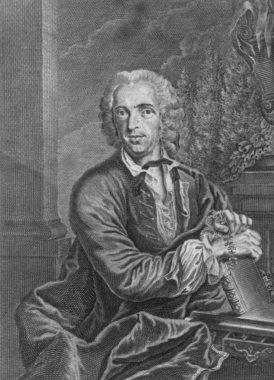
Carl Linnaeus, 1707-78. The famous botanist at forty-one, from the frontispiece of the 1748 edition of his Systema Naturae. (Thomas Fisher Rare Book Library, University of Toronto) |
Linnaeus was particularly interested in the plant kingdom and began his work by collecting specimens and ranking them in order of similarity of appearance. As was usual among scientists of his day, he used Latin descriptive names to identify each class and order, which were then subdivided again into genera and, finally, species. He regarded species as the units of creation; for him each species bore the impression of the original ideas of the Creator, not only in external form but in anatomical structure, faculties, and functions. In this he recognized purposeful design and a designer. Today, classification is made on the same basis, that is by similarity of design features, except that the word "homology" has replaced the word "design". Undoubtedly, this change of word was done quite innocently but it has had the effect of making a second important step away from the biblical concept: it avoids all inference to a designer. In the Linnean system every species was intermediate in appearance between two others but not fertile with them; members of a species were only fertile one with another. In the case of the plants his method of determining species depended upon counting and measuring the sexual parts of the flower so that distinction was quite positive depending upon the precision of numbers. His sexual system recognized, for example, that those flowers with five stamens would not cross with those having six and thereby assigned them to separate species. |
The systematic genius of the Linnean system was not without its critics, especially as Linnaeus based his method on what he referred to as the "loves of the plants". Barber says that Linnaeus was inclined to "overemphasize the metaphorical possibilities of his sexual system". He referred for example to "Diandria" as two husbands of equal rank (stamens of equal length) in the same marriage, and "Polyandria" as "twenty males or more in the same bed with the female" (Barber 1980, 52). One critic writing in 1736 doubted very much if any botanist would follow the "lewd method" of Dr. Linnaeus (Black 1979, 98).
In Linnaeus' system all organisms formed an ascending scale from the
lower organisms to the higher, with man at the summit, but they were not
related. Linnaeus took the unusual step for his day of including man,
Homo
sapiens, in his scheme and placing him in the same genus as the orangutan,
Homo
troglodytes.
Recognizing that there are much greater differences than
first assumed by Linnaeus, the orangutan has since been reassigned to the
genus Pongo. Nevertheless, in Linnaeus' system this ascending scale
was not evolution (phylogeny) but merely a convenient way of classification
and identification (taxonomy). Linnaeus believed firmly in Special Creation
and the fixity of species and stated, "We reckon as many species as issued
in pairs from the hands of the Creator" (Osborn 1929, 187).[8]
| Linnaeus introduced his system of plant classification in his Systema Naturae in 1735 and in this and subsequent editions there is no hint that one species is related to another through some ancestral form. Himmelfarb claims that in the final edition of his Systema Naturae published in greatly expanded form thirty-one years after the first, Linnaeus tentatively suggested that the original number of species created may have been multiplied by interbreeding one species with another (Himmelfarb 1968, 170).[9] However, the most likely explanation was that two extreme variants within a single species had been assigned the status of separate species in error. Linnaeus recognized that variation was possible within a species but was often not sure where one species ended and another began; it would have been a natural temptation to speculate that a new species had been created by crossbreeding when, in fact, it was only a variant within the species. Linnaeus saw some of the more extreme variants as degenerate forms of the perfect archetype that God had created. He remained convinced that the species were immutable. Clark (1948, 39) writes that his belief remained unshaken by anatomical resemblances which he frequently found to exist between animals of different species. In Linnaeus' mind this was simply the designer's use of a common design. |
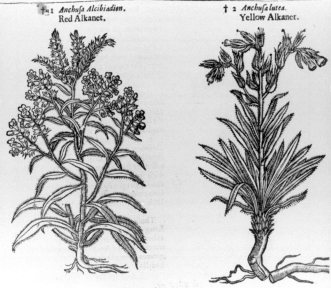
Example from an illustrated herbal of 1633. The text to this woodcut of the Anchusa plant states that the leaves can be used "as a pessary to bring forth the dead birth". (Metropolitan Toronto Reference Library Board) |
The monumental Systema Naturae was internationally accepted by nineteenth century naturalists as the starting point for the modern scientific naming of all organisms. The familiar Latin binomial, that is, the generic and specific names, which are usually found appended to plants and animals in our zoos and museums, are a direct result of classification by Linnaeus. Even today taxonomists occasionally find it necessary to refer back to the works of Linnaeus when checking authorities for names.
After the introduction and establishment of Darwin's theory, taxonomists Engler and Prantl, in 1915, rearranged some of Linnaeus' system to conform to the assumed evolutionary history of the organisms, that is, in accordance with their phylogeny or line of descent from ancestral forms. In contrast to the intentions of Linnaeus, similarity of design had now come to mean relatedness by a common ancestor. The Linnean hierarchy of kingdom (animal, mineral, or vegetable), class, order, genera, and species is still followed today, but with the addition of several other divisions and subdivisions such as phylum, family, and sometimes subspecies. The evolutionary term "family" emphasizes the supposed relatedness in a powerful way, and it has become commonplace, for example, to speak of the lion, tiger, panther, etc., as being part of the cat family (Felidae). In very few cases is there sufficient evidence to say that there is any relationship and it is all assumed on the basis of appearance and habits. One notable exception is the Canidae family, that is dogs, wolves, jackals, etc., where enough is now known to be reasonably certain that these are indeed all related and probably had a common, though still dog-like, ancestor. More will be said of this in Chapter Six. In Linnaeus' scheme each species observed was descended more or less unchanged from that created in the beginning.
A final note to the work of Linnaeus: when he died in 1778 all his specimens,
books, and letters were sold to a wealthy English collector who founded
the Linnean Society of London.[10]
This Society soon became the focal gathering point for the world's leading
naturalists of the nineteenth century and is an honored institution that
still operates today, from Burlington House in the heart of England's capital.
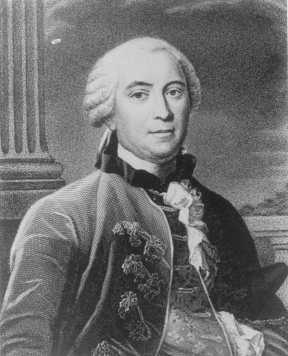
Comte de Buffon, 1707-1788. Opposed the ideas of Linnaeus and prepared the ground for Charles Darwin. (Engraving after a painting by Hubert Drouais) |
Comte de Buffon
Though he was born within four days of Carl Linnaeus, Georges-Louis Leclerc Comte de Buffon's background was in complete contrast (Roger 1970). Far removed in distance and culture but not in time, Comte de Buffon was born of French nobility and lived during a period when the class into which he was nurtured enjoyed every cultural and financial privilege. Not only did he inherit every social advantage, but he was gifted with a great intellect which he exercised diligently in many fields of endeavor. Buffon's formative years were spent at a Jesuit college in Dijon, where he showed a natural aptitude for mathematics; in fact, at an early age he not only had a good understanding of Isaac Newton's "Fluxions" -- better known today as differential calculus -- but he translated that scientist's work into French. Wealthy and successful in every branch of eighteenth century science, the Comte de Buffon spent more than fifty years until the time of his death as director of the Jardin du Roi in Paris; during this time he published his Histoire Naturelle, an enormous work of ten volumes. One of Buffon's talents was the ability to communicate to others enthusiasm for his own imaginative ideas, and he quickly became a legend in his own lifetime; this hardly contributed, however, to his sense of modesty. He once declared that there were only five great men in the history of mankind: Newton, Bacon, Leibniz, Montesquieu -- and himself. |
Buffon was not a religious man. As a youth under Jesuit training, he would have been familiar with the book of Genesis, taught at that time with a literal interpretation. In his earlier years Buffon gave nodding assent to the divine Creator and the fixity of species, but in his later years he rejected the biblical account of Creation and any supernatural attributes entirely. Eventually, his ideas were at complete variance with those of Linnaeus, and, in fact, he became his principal rival and critic.
Buffon did not use the word evolution, but it is nevertheless true that he laid the basis for modern evolution in systematic botany and zoology. He was the first to propose on a broad scale the mutability of species in relation to changes in environment. He proposed the view that over a number of generations and under the influence of the environment, one species could gradually change into another. This was in direct contrast to the fixity of species maintained by the book of Genesis and Linnaeus. He further believed that modifications imparted to a species by the environment are passed on to the offspring. The idea is described as "the transmission of acquired characteristics" today, but Buffon did not express it in these terms. The idea itself, however, was a fertile seed planted in the young mind of Lamarck, one of Buffon's pupils and admirers.
Buffon's work extended over many subjects, including geology. In the late 1700s fossils were becoming objects of interest and were generally acknowledged to be the direct evidence of the Genesis Flood, or Deluge as it was then called. Buffon refused to accept the idea of catastrophes or the biblical Flood and saw fossils to be the result of a former gradual submersion of the continents. He offered no explanation for their reemergence, and, as far as latter-day proponents of the same theory are concerned, a satisfactory explanation for the reemergence of continents is still awaited. In his Epoques de la nature, published a decade before he died, Buffon suggested that the earth's beginning took place by a piece being torn out of the sun, which took on a spheroidal shape and a heliocentric orbit to become the earth. The moon was then torn from the earth and became a satellite to it; all this happened 75,000 years ago (Roger 1970, 578). This notion of the moon's origin was resurrected exactly one hundred years later, in 1879, by George Darwin (1879; 1880), son of Charles Darwin. Buffon's speculations were in direct conflict with the orthodox view of the day, which held that the earth was created about four thousand years before the time of Christ. While the Bible itself does not include dates, the time of Creation had been calculated from the lists of genealogies and had by this time become church dogma. Buffon wrote his ideas in a thinly veiled, rhetorical stratagem by which he hoped to avoid ecclesiastical censure. The faculty of theology at the Sorbonne was not taken in by this device, however, and he was obliged to recant in writing everything in his works that might be taken to contradict the biblical account of Creation.
Buffon sowed the seeds of the idea of evolution, and these later germinated
in the minds of his successors. But the censure he received from the church,
together with the towering authority of Cuvier who, succeeded Lamarck,
delayed the acceptance of the evolutionary concept by at least half a century.
In addition, Buffon's contemporary, the Swede Linnaeus, even though geographically
remote from the cultural and intellectual center of Europe, had by sheer
genius as an observer and classifier made a much greater impact on the
world of science than Buffon. That influence even survived the great revolution
brought by Darwin and is still felt today. We see in this a lesson. For
a new and revolutionary idea to take root and grow in the collective mind
of the people, the seedbed has to be prepared beforehand. This was specifically
Buffon's function. His ideas were spread as seeds, then the ground turned
over and lay fallow in readiness for the Darwinian springtime.
| Jean-Baptiste Lamarck
Buffon was undoubtedly saved from the ignominy of the guillotine by a timely death at the age of eighty-one, just a year before the French revolution. He was survived for a short time by his son, who subsequently lost his life to the guillotine during the Reign of Terror in 1793. The fury of the mob had extirpated king and nobility and silenced the ecclesia; now freed from the shackles of royalty and Rome, they sought to bring into being their Utopian government, the republic. The Jardin du Roi -- king's garden -- which had been under the lordship and tutelage of Buffon for more than half a century, was left somewhat in limbo after his death, due to the uncertainty of the times. Eventually, however, the French revolutionary government, seeking to promote science while reforming society, elected a new director to the Paris institution, which they renamed the Jardin des Plantes; the new director's rather impressive name was Jean-Baptiste Pierre Antoine de Monet, Chevalier de Lamarck. Lamarck was born in 1744, the youngest of eleven children, into the family of the once distinguished line of barons of Saint-Martin du Picardie. At the time of his arrival, however, the family was quite impoverished. At the age of eleven he went to a Jesuit school to become a priest, but at fifteen left to join the army. At twenty-four he studied medicine for four years in Paris, but drifted from medicine to amateur botany and literary hack-writing. Then in 1779 he published his work French Flowers, which gave him recognition as a botanist. He held minor posts under Buffon at the Jardin du Roi and eventually became the director in 1793. The Jardin des Plantes was a small part of the much larger Museum d'Histoire Naturelle, which later became a world center under Georges Cuvier. |
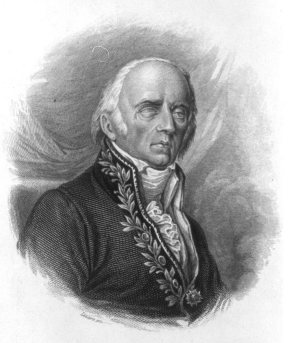
Jean Baptiste Lamarck, 1744-1829. An unusual portrait showing the subject blind in his final years. Lamarck was convinced that physical characteristics acquired by the present generation could be inherited by the next. Known as "Lamarckism", the notion is now totally discredited. (Thomas Fisher Rare Book Library, University of Toronto) |
As a scientist, Lamarck was moderately successful; his personal life was, however, a continual disaster. At thirty-three he began a liaison with Marie Delaporte and married her fifteen years and six children later, as she lay on her deathbed. He married again, and after two children, his second wife died; his third wife died childless when he was seventy-five. He was in poor health from sixty-five on and was blind for the last ten years of his life. When he died at eighty-five, he was penniless, and his children had to appeal to the state for funeral expenses. Even his children were not spared: of the five that survived, one was deaf, one insane, two were single daughters without support, and only one was successful, as an engineer (Burlingame 1973). Fate did not spare him even after death; during his life his ideas were ridiculed in many quarters, while the final blow came with the eulogy delivered by his superior Cuvier, who pointed out that science had no use for theories but was far better founded on facts (Thomson 1932, 47).[11] Lamarck died ignored and largely forgotten for at least a generation, after which his ideas were briefly resurrected for, one suspects, political rather than scientific motives.
Until sometime in the 1790s, he believed in the biblical fixity of species, but then his ideas changed. His biographers are uncertain of the reason, but putting two wives in their graves and marrying a third in a relatively short time may have hardened his mind against the existence of a caring God. After 1800 -- he was then fifty-five -- he abandoned his belief in divine creation and began to advocate his ideas for evolution of life, although he did not use the word evolution. In his Recherches, published in 1802, he noted that fossils found in the various rock layers indicated that animals in the past had become extinct, then suddenly appeared again in the fossil record. Having abandoned the idea of Special Creation, he was forced to propose that life had the ability to begin again spontaneously; he did not explain, however, how this came about. Lamarck had been very much influenced by Buffon, and, like his mentor, had a rich imagination. In his Philosophie zoologique, published in 1809, he expanded on his theory for the origin of the variety of life forms, past and present. Like others of his time, Lamarck saw living things as forming a hierarchy, from the lowest orders with the least specialization to the highest with the greatest specialization. This was referred to as "the great chain of being"; it would be a long time before such expressions were replaced by the word evolution. He proposed that the shape or size of animal organs was modified according to the circumstances in which the creature might find itself. These slight changes, acquired, for example, because of a changed environment, would then be passed on to the offspring.
Lamarck's proposal, which was developed from Buffon's original idea, is described as "the inheritance of acquired characteristics", today more simply known as "Lamarckism". For Lamarck this was the key mechanism whereby one species, finding itself in a new environment, would develop in the course of many generations, eventually to become a new species, perfectly adapted to the new environment. Lamarck did not state that this happened because of a conscious need on the part of the creature, but as a result of a developed habit, in today's jargon called a "reflex action". In a few classic examples of this view, the giraffe obtained his long neck by browsing on the tall branches of trees, birds who lived in water acquired webbed feet, and moles became blind as a result of living underground. The orthodox explanation was, of course, that these creatures had been specifically designed for each type of environment. Lamarck also made a categorical denial of past catastrophes, referring to the Genesis Flood, and proposed, instead, gradual changes occurring over very long times. When Lamarck published these ideas in 1809, the Roman church authorities in Paris, who had just a few years before forced Buffon to recant but were now made impotent by the revolution, remained silent.
Lamarckism is one of those explanations for life that at first may seem reasonable and for which supporting evidence can always be found. But closer inspection shows that it is really not a valid theory. The baldness that ran through Darwin's family from grandfather to father, to son, to grandson, and to great-grandsons was an inherited trait and was not acquired by habit. The Jews have practiced circumcision for four thousand years, but August Weismann's (1891, 1:447) statistical work showed that this physical change has never once been inherited.[12] Lamarckism went to the grave with its author, although, strangely, it is resurrected from time to time. For a recent example, see Gorszynski and Steele (1981).[13]
The Lamarckian notion lingered on in the minds of some; however, even Darwin, half a century later, although outwardly he spoke against him, inwardly entertained Lamarckian thoughts as explanations of certain "difficult" steps in evolution. After Darwin published his theory of evolution in 1859, some European countries, perhaps piqued that the key to life's secrets had been discovered on England's shores, erected an alternative evolutionary model called neo-Lamarckism -- a new version of Lamarck's theory.
After Darwin died, the intellectual atmosphere surrounding his theory of evolution became a little more liberal, and by the turn of this century Gregor Mendel's genetics were being understood and accepted. The work of August Weismann (1893) on the division of cells then showed that certain germ cells were produced during the embryo stage which were responsible for the characteristics of the next generation. This explained why almost anything could happen to the parent, but as long as the germ cells were not damaged, the offspring would not inherit any defects, such as missing limbs, and so on. Weismann's (1891, 1:444) classic experiment, in which he cut the tails off a total of 901 white mice in five successive generations, showed that each new generation was born with a perfectly normal tail -- not a single tail was shorter than usual.[14] This experiment perhaps more than any other finished Lamarckian and neo-Lamarckian ideas, at least in the West, nearly a century ago, although as we will see later in this chapter Lamarck's thinking continued in Russian biological science until the mid-1950s.
Lamarck, as with Buffon before him, had been an apostle of the doctrine
of evolution and had proposed a mechanism that was later shown to be illusion
rather than fact. However, public consciousness was not yet ready to accept
evolution, and the principle lay dormant, waiting for acceptance in the
next generation.
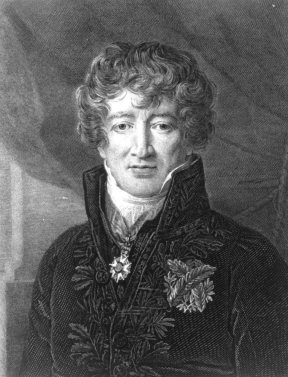
Georges Cuvier, 1769-1832. As father of the science of paleontology and capstone of the French scientific establishment, Cuvier had great influence. His theory of creation withstood the theory of evolution in France for almost the entire nineteenth century. (Engraving from a portrait of Cuvier at fifty-seven; Sigmund Samuel Library, University of Toronto) |
Georges Cuvier
The biographies of men such as Linnaeus or Cuvier tend to leave most readers feeling slightly inadequate. Their sheer capacity for work and their expertise in a multitude of areas leave them standing as giants amid the throng of mere mortals of their day. Yet they too were mortal and showed the peculiarities of habit often found among the exceptionally gifted. Georges Cuvier was born into a poor Protestant family in an area of France near the Swiss border. The people in this area were Lutheran, and he was raised in the period just before the French Revolution when Protestants were in constant danger of persecution (Bourdier 1971) By the age of fifteen Cuvier had shown himself to be a very bright student, and a wealthy patron paid for him to go to Caroline University near Stuttgart, Germany. When writing letters home or to his Lutheran minister uncle, Cuvier had to be careful not to say anything pertaining to religious views that could give the French secret police cause to persecute his family. He graduated in medicine at nineteen, having had to learn German while an undergraduate. Good fortune protected him from the turmoil of the revolutionary years. With the return of at least some measure of political stability in France, he came back to Paris to join the newly reorganized Museum d'Histoire Natu-relle as professor of zoology, in 1795; he was just twenty-six. |
Many investigators of the day saw fossil remains as direct evidence
of the great Genesis Flood, but as they began to observe further, they
saw indications of alternating periods of extinction and reemergence of
the species in the rock layers. It looked as if there had been a succession
of catastrophes, whereas the Bible spoke of only one; the faith of some
began to waver. Cuvier himself became very involved with fossil study and
developed a paleontological technique for deducing from a single bone or
part of a bone the identity and structure of the entire animal, even those
that were extinct. This technique depended on a vast and intimate knowledge
of virtually every bone known to zoology. Cuvier soon acquired an international
reputation which continued to grow since he had a phenomenal memory and
was seldom found to be wrong.
| At the age of thirty-five he had achieved success and professional reputation, although his Christian faith had been severely shaken by the fossil record. All the evidence seemed to indicate a great age for the earth rather than the few thousand years of the Mosaic account. At this point he married a Protestant widow with four children, and it is reported that he then had a revival of his faith (Bourdier 1971, 526). Shortly after this he developed a theory for the earth that nicely reconciled geology with Genesis. He made his theory first known in 1812 as part of his massive Recherches sur les ossemens fossiles des quadrupedes, and later more popularly in his Essay on the theory of the earth. In this latter he said that in the remote beginning God supernaturally created all species of living things. The earth had subsequently experienced a succession of violent floods caused by rising sea levels that had devastated most of the animal and plant life on earth. Isolated geographical areas had always been spared and the living species had propagated themselves anew from these areas. Nordenskiold (1928, 338) says Cuvier expressly included man in this view. The last of these catastrophes was the Genesis Flood, which was worldwide, but in this case the living things had been spared on the ark of Noah. The theory seemed to account for the fossil record and permitted as many years as were required by geology for the catastrophe-repopulation cycles. He explained that God had not provided us with details of the early stages but had simply given the record since the quiet time before the great Flood. The theory allowed six thousand years or so from the beginning of the Bible record to the present time. He believed in the fixity of species, but in mid-life wavered towards the theory of the "chain of being," |
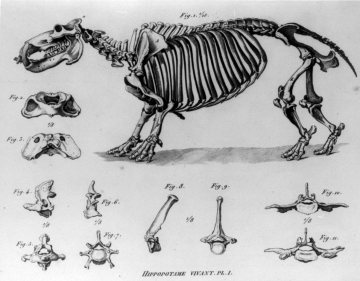
Plate 30 from the atlas to Cuvier's Recherches sur les ossemens fossiles des quadrupedes showing how isolated fossil bones may be identified from similar structures in living animals; in this case, the hippopotamus. (Sigmund Samuel Library, University of Toronto) |
In France at that time it was often a matter of being politically correct and later, under Napoleon, the Book of Genesis once more became "correct" and in his last days Cuvier proclaimed his belief in the fixity of species (Coleman 1964).[15 ] Nordenskiold (1928, 338) corrects the common misconception which claims that Cuvier said God recreated all living things after each catastrophe.[16] This misunderstanding is reported in textbook after textbook and leads to the view that God made numerous attempts at Creation and finally got it right on the last occasion. However, this was not Cuvier's position at all. Cuvier's theory was eagerly accepted in England, where many divines of the day were amateur geologists. In Cuvier's scheme the Scriptures were seemingly not violated, leaving the divines to pursue their hobby with a clear conscience.
Cuvier's theory of creation became a kind of dogma that actually dominated French science through the nineteenth century, long after Cuvier had been honored in a state funeral in 1832. It may be appreciated that within any organization, whether it be a nation, a large industry, or a discipline such as natural science, there is a pyramid of power in which the beliefs of the man at the top are reflected all the way down throughout the entire structure. French science under the new socialist government was concentrated in Paris at the Museum d'Histoire Naturelle, and Georges Cuvier was the man at the top.
The situation was no different from any university or government research laboratory of today. The candidate for employment first had to show evidence of conforming to the ideas of the establishment; once accepted, conformity was expected in order to ensure continuation of salary and promotion. The system virtually guarantees maintenance of any theory -- regardless of whether the theory is sound or not -- held by the man with ultimate authority. Not only that but in a hierarchical system, promotion from within ensures that the theory is perpetuated generation after generation. Cuvier's theory was not sound, but it had become so well entrenched through its founder and followers that it remained and, it is claimed, seriously handicapped French science for almost the entire century, retarding the acceptance of Darwin's theory of evolution at least until the early 1900s.
The folly of the totalitarian hierarchical system, in which a theory or a policy of one human being is maintained even in the face of contrary evidence, was displayed more recently in Russia. All of Russia's biological and agricultural research efforts until the 1950s were retarded because the director in charge of the Socialist government research organization, Trofim Lysenko, was convinced of the validity of Lamarck's theory of the inheritance of acquired characteristics (Gould 1981a, 14).
In contrast, Cuvier's theory of creation did not remain in the minds
of the scientific community in England for very long; in fact, it began
to wane with the publication of Charles Lyell's work on geology in the
1830s. It is suggested that the short survival was largely due to the capitalist
government in England, which at the time actively fostered new inventions
and new ideas as a vital part of the Industrial Revolution. As we shall
see in later chapters, men such as Charles Lyell and Charles Darwin, who
were the fathers of the new theory of evolution, were independent and wealthy.
They were subservient to no research director and were free to develop
their theories, and, perhaps more importantly, to publish their ideas.
The irony is that under the capitalist system of nineteenth century England,
it was possible to publish ideas, whether sound or not, quite freely. Under
the socialist government of France, meanwhile, although liberty was proclaimed,
at least within the scientific community, the freedom to publish seems
to have been entirely lost.
|
|
| << PREV |
|